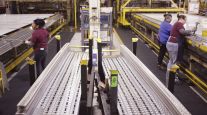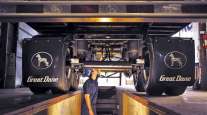Trailer Orders Keep Rising; Plants Ramp Up Capacity
This story appears in the Feb. 6 print edition of Transport Topics.
Trailer makers experienced robust ordering activity to end 2011 and early this year, according to ACT Research Co. and interviews with manufacturers.
Fleets ordered 28,078 new commercial trailers in December, a 20% increase from the 23,395 ordered in the same month in 2010, ACT, Columbus, Ind., reported on Jan. 25. Orders slipped slightly from the November figure of 28,229.
For the full year, customers ordered 235,318 new trailers, a 38% increase from the 170,526 units ordered in 2010.
“The market is very strong still and no signs of slowing,” Craig Bennett, senior vice president for sales and marketing at Utility Trailer Manufacturing Co., City of Industry, Calif., told Transport Topics.
ACT also reported that manufacturers built 212,924 commercial trailers last year, a 69% jump from the 125,929 they produced in 2010.
“The builds are different from actual sales,” said Steve Tam, ACT’s vice president for the commercial vehicle sector. “As the name implies, these are the number of trailers the companies built during the year. Most were probably destined for fleets that had ordered them, but others went to dealer lots, where many of the smaller and midsize carriers buy their trailers.”
Trailer makers built 18,033 trailers in December, a 37% increase from the 13,165 they built last December.
“It seems as if someone turned the faucets on during the second week in November, and we’ve been receiving very steady, strong orders since, which continued throughout December and into January,” Charles Mudd, president of Vanguard National Trailer Corp., Monon, Ind., told TT on Jan. 25. “We’re currently sold into October of this year.”
Mudd said that Vanguard built 7,000 trailers in 2011, a 56% increase from the 4,500 units that the company built in 2010.
He said the company’s plant was operating at full capacity and was discussing ways of increasing output, but no decisions have been made.
“We expect orders to slow down in the next few months, not because of falling demand but because the production isn’t available,” Mudd said. “We’ll book new orders only so far out. Once you get to booking orders three quarters out, we’d be guessing on material costs, and that’s scary.”
Dry vans are still the hottest segment, reefers were still in high demand and flatbed trailer activity had picked up dramatically, Bennett said.
“Our 2011 unit sales were up over 40% from 2010,” he added. “Backlogs vary from April to July, depending on the model.”
Most Utility customers still were replacing older trailers, he said, but “some are growing their fleet size. They are the financially more wealthy customers.”
Utility has been able to keep price increases stable, Bennett said, except for “tire costs . . . going up the most of any item on the trailer.”
“All activity really picked up in the fourth quarter and ran at a similar level of activity in December, except for the holiday week, which is normal,” Chris Hammond, vice president of dealer sales at Great Dane Trailers, Savannah, Ga., told TT. “So far, it’s been just as good in January, and that’s a good sign.”
Great Dane posted a “double digit” increase in production in 2011, he said, compared with 2010.
“All of our lines have backlogs that are getting deeper into the second quarter, at a minimum,” Hammond added.
“I think a lot of people are ordering because their fleets are old,” he said, adding that customers who haven’t bought in a decade were pleasantly surprised. “Our products are a lot more advanced than eight or 12 years ago.”
“Business has been pretty consistent — strong in December, good in January,” David Giesen, vice president of sales and marketing at Stoughton Trailers, Stoughton, Wis., told TT. “We had a very good January in 2011, and we’ll probably have a better January this year. It is the consistency that we like.”
Stoughton built 8,500 trailers in 2010 but 9,700 in 2011, and expects to exceed 11,000 builds this year, Giesen added.
“We have some build slots available in the second quarter, but we’re mostly booking into June and July now,” he said.
“We are planning on increasing capacity throughout the year,” he added. “Through our current infrastructure, we can feed more productivity. We just have to be adding employees. We haven’t come up with the total number, but we hope to grow our employment each week.”
ACT’s Tam said that, after two growing years of trailer manufacturing, “we won’t see the same growth this year but rather increases in the range of 15% to 20% in production. Trailer manufacturers should like that.”




